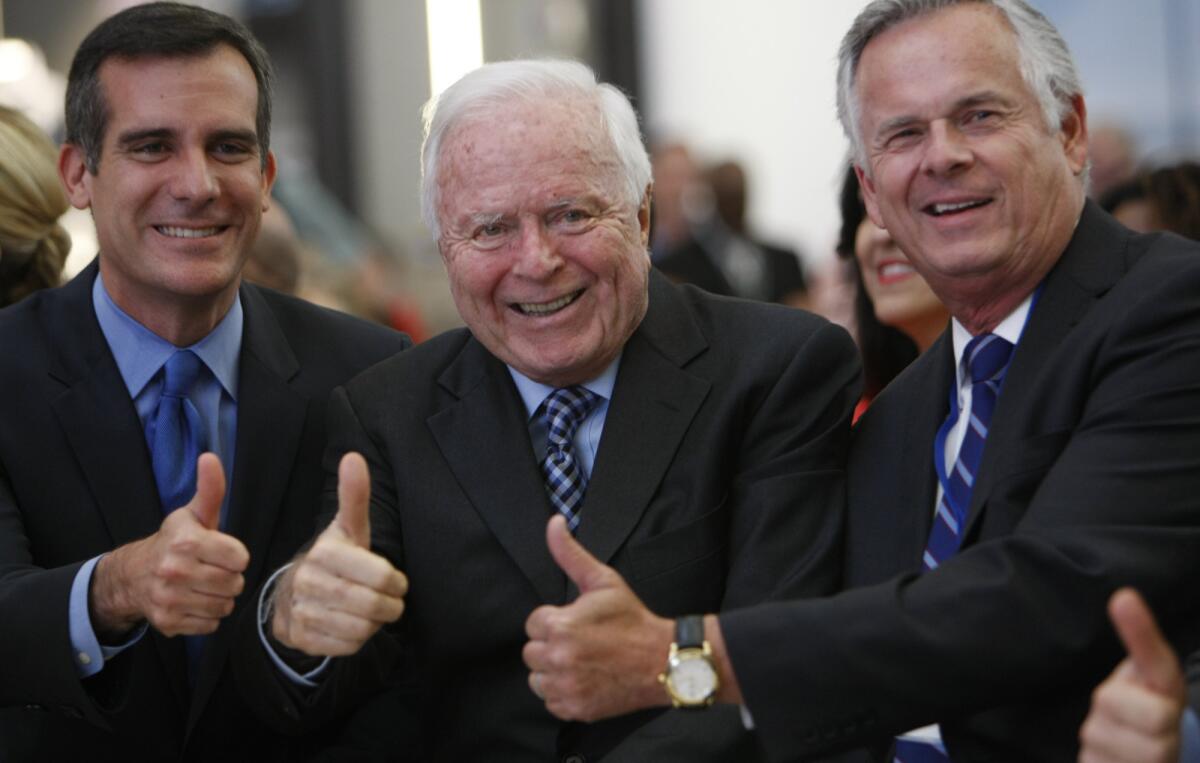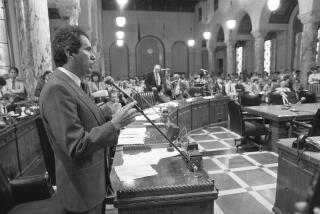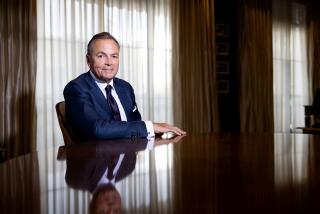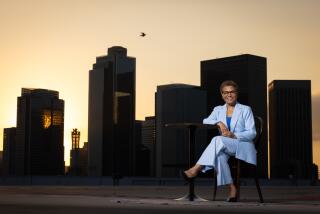Commentary: ‘The Mayor’ by Richard Riordan short on revelations, insight

Former Mayor Richard Riordan, center, shares a thumbs up with Mayor Eric Garcetti, left, and ex-Mayor James Hahn at an LAX ceremony in 2013.
In his long public life in Los Angeles, including eight years as mayor, few ever accused Richard J. Riordan of being the Great Communicator.
Sincere. Awkward. Generous. Tone deaf. Unbending. Passionate. All of those, yes. But capable of moving people with words — eloquent, funny or incisive words? Riordan seldom faced that accusation, even from his friends.
It comes as a disappointment but not much of a surprise, then, that the autobiography of the city’s only Republican mayor in recent memory fails to provide fresh perspective on Riordan or on what the Riordan years really meant. “The Mayor: How I Turned Around Los Angeles After Riots, an Earthquake and the O.J. Simpson Murder Trial” (Post Hill Press: 252 pp., $27) offers a dutiful account of Riordan’s early life, climb to business riches, two terms at City Hall and post-mayoral decades.
But only occasionally does the book (written with former LA Weekly reporter Patrick Range McDonald) reach for something fresh or unveil events previously unknown. In most of its 247 pages, “The Mayor” is bereft of the sort of telling anecdote, or novel observation, that would offer readers a new intimacy with their subject.
(Disclosure: I covered Riordan when he ran for mayor and during his first years in office; in a brief episode from the book, Riordan recalls a 1993 article written by another reporter and me that he strongly objected to.)
Riordan’s life has the makings of formidable biography: The now 84-year-old has endured a tsunami of personal drama — beginning with an emotionally austere childhood and progressing through the untimely death of two siblings, the passing of two of his own children and three failed marriages.
The late-in-life politician also rose to prominence in a time of virtually unprecedented turmoil in Los Angeles — at the end of Tom Bradley’s two-decade reign as the city’s longest-serving mayor, following the hideous Rodney King beating and after the 1992 riots had sealed the perception of L.A. as a hothouse of urban dysfunction.
The conventional view of many of his contemporaries is that the city experienced considerable healing by the time Riordan left office in 2001. The mayor counted a solid expansion of the Police Department and the rewriting of the City Charter, creating neighborhood councils and easing the path for firing underperforming bureaucrats, among his successes.
He failed to fully embrace the need for other fixes, however, such as reform of the sometimes brutal and maverick LAPD. And he never mastered politics and relations with a headstrong and parochial City Council, which limited his effectiveness. Many of his biggest achievements, not coincidentally, came by working outside of government — collaborating with the private sector to assure the creation of landmarks such as Staples Center and Walt Disney Concert Hall.
A lot of what Riordan offers in “The Mayor” doesn’t go much beyond what one could glean from a thorough review of the press coverage of the time. He describes how, before taking office, he worked for months to try to quietly negotiate the retirement of obstreperous Police Chief Daryl F. Gates, the macho top cop who went absent in the hours at the start of the riots. Riordan even wrote Gates’ much-delayed resignation letter.
But his book offers almost nothing novel about how this watershed moment came to pass. What did he say to edge the famously proud chief toward the door? How and why did Gates stall?
Riordan put his investment empire on a side burner when he ran for mayor in 1993. His opponents, including Councilman Michael Woo, depicted him as a heartless capitalist who would turn over City Hall to a bunch of corporate cronies.
That caricature long since has been vanquished by Riordan’s many good works, particularly in philanthropy. His book has value in reminding us how often he cut against convention, often to help the less fortunate.
When much of the city, including grocery stores, closed following the riots, he launched his own relief effort — paying to establish makeshift produce markets and to send mobile medical vans into Watts and South L.A. He fought vehemently against San Fernando Valley secession, and a prime motivation was his belief that it was “morally and ethically wrong for more affluent communities ... to abandon poorer ones.”
“The Mayor” fleshes out the historical record on at least a few points as well. Riordan gives a fuller accounting of his falling out with longtime consigliere Bill Wardlaw and describes how he cursed and lost his temper with then-Gov. Pete Wilson. His fellow Republican had just told the mayor that it would take months to fix bridges damaged in the 1994 Northridge earthquake.
Riordan makes it abundantly clear in “The Mayor” that he feels the Los Angeles Times targeted him unfairly during much of his political life. Journalists at the newspaper felt they were merely holding him accountable. In the one anecdote in the book that I experienced most directly, Riordan criticizes a 1993 article written by reporter Frank Clifford and me. “The headline and story ... were clearly slanting things to make me look as if I was a racist,” he writes.
The article quoted a story in the Dallas Morning News about a campaign trail incident. The mayor had visited the home of an elderly white woman who said: “Black people are just awful. Don’t you think so?” Riordan replied: “Some of them.”
In his book, the Riordan of 2014 explains, “I would would have responded the same way if she asked if white people were awful, or businessman, or woolly mammoths.” But at the time, a small blip on the 1993 election radar grew slightly larger because Riordan denied he had replied to the voter, even though a tape recording confirmed he had.
While imprecision is one shortcoming, a more unfortunate one for today’s readers may be the book’s failure to play his story forward. Riordan became the first mayor to seriously intervene in the politics of the Los Angeles Unified School District. But has subsequent mayoral intercession in school board races bettered the public schools? Pushing ahead with his expansion of the LAPD has been a preoccupation of future mayors. But have other city services suffered? And what effect did the force’s growth have on pension costs, an issue Riordan has focused on in recent times?
This autobiography does not venture into any of that ground.
Dick Riordan may have been “tough enough to turn L.A. around,” as his 1993 campaign slogan suggested. One wishes he had been tough enough to take a harder, more detailed and more forward-thinking look at his own legacy.
Twitter: @latimesrainey
More to Read
Sign up for our Book Club newsletter
Get the latest news, events and more from the Los Angeles Times Book Club, and help us get L.A. reading and talking.
You may occasionally receive promotional content from the Los Angeles Times.









